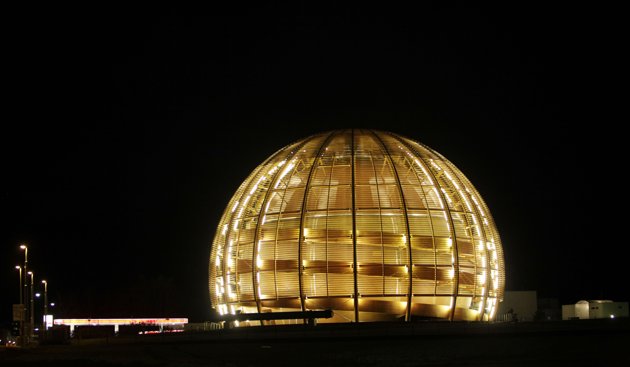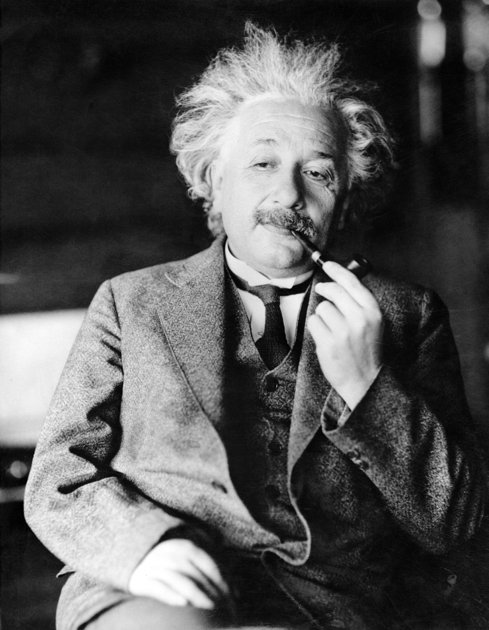By FRANK JORDANS and SETH BORENSTEIN - Associated Press | AP – September 23, 2011

1. FILE - In this Tuesday, March 30, 2010 file photo, the globe of the European Organization for Nuclear Research, CERN, is illuminated outside Geneva, Switzerland. Scientists at the European Organization for Nuclear Research, or CERN, the world's largest physics lab, say they have clocked subatomic (小于原子的;亚原子的) particles, called neutrinos (微中子), traveling faster than light, a feat (功绩) that, if true, would break a fundamental pillar (支柱) of science, the idea that nothing is supposed to move faster than light, at least according to Einstein's special theory of relativity: the famous E (equals) mc2 equation. That stands for energy equals mass times the speed of light squared. The readings have so astounded researchers that they are asking others to independently verify the measurements before claiming an actual discovery. (AP Photo)

2. This undated file photo shows famed physicist Albert Einstein.
*****************
GENEVA (AP) — A startling find at one of the world's foremost laboratories that a subatomic particle seemed to move faster than the speed of light has scientists around the world rethinking Albert Einstein and one of the foundations of physics.
Now they are planning to put the finding — and by extension Einstein — to further high-speed tests to see if a revolutionary shift in explaining the workings of the universe is needed — or if the European scientists made a mistake.
Researchers at CERN, the European Organization for Nuclear Research, who announced the discovery Thursday are still somewhat surprised themselves and planned to detail their findings on Friday.
If these results are confirmed, they won't change at all the way we live or the way the universe behaves. After all, these particles have presumably been speed demons for billions of years. But the finding will fundamentally change our understanding of how the world works, physicists said.
Only two labs elsewhere in the world can try to replicate the results. One is Fermilab outside Chicago and the other is a Japanese lab put on hold by the tsunami and earthquake. Fermilab officials met Thursday about verifying the European study and said their particle beam is already up and running. The only trouble is that the measuring systems aren't nearly as precise as the Europeans' and won't be upgraded for a while, said Fermilab scientist Rob Plunkett.
"This thing is so important many of the normal scientific rivalries fall by the wayside (fall by the wayside:半途而废:无法继续;放弃)," said Plunkett, a spokesman for the Fermilab team's experiments. "Everybody is going to be looking at every piece of information."
Plunkett said he is keeping an open mind on whether Einstein's theories need an update, but he added: "It's dangerous to lay odds against Einstein. Einstein has been tested repeatedly over and over again."
Going faster than light is something that is just not supposed to happen according to Einstein's 1905 special theory of relativity — the one made famous by the equation E equals mc2. Light's 186,282 miles per second (299,792 kilometers per second) has long been considered the cosmic (宇宙的) speed limit. And breaking it is a big deal, not something you shrug off like a traffic ticket.
"We'd be thrilled if it's right because we love something that shakes the foundation of what we believe," said famed Columbia University physicist Brian Greene. "That's what we live for."
The claim is being greeted with skepticism inside and outside the European lab.
"The feeling that most people have is this can't be right, this can't be real," said James Gillies, a spokesman for CERN, which provided the particle accelerator to send neutrinos on their breakneck (极快的,非常危险的) 454-mile trip underground from Geneva to Italy. France's National Institute for Nuclear and Particle Physics Research collaborated with Italy's Ran Sass National Laboratory for the experiment, which has no connection to the Large Harden Collider located at CERN.
Gillies told The Associated Press that the readings have so astounded researchers that "they are inviting the broader physics community to look at what they've done and really scrutinize (细看,仔细检查) it in great detail."
That will be necessary, because Einstein's special relativity theory underlies "pretty much everything in modern physics," said John Ellis, a theoretical physicist at CERN who was not involved in the experiment. "It has worked perfectly up until now." And part of that theory is that nothing is faster than the speed of light.
CERN reported that a neutrino beam fired from a particle accelerator near Geneva to a lab 454 miles (730 kilometers) away in Italy traveled 60 nanoseconds faster than the speed of light. Scientists calculated the margin of error at just 10 nanoseconds, making the difference statistically significant.
Given the enormous implications of the find, they spent months checking and rechecking their results to make sure there were no flaws in the experiment.
A team at Fermilab had similar faster-than-light results in 2007. But that experiment had such a large margin of error that it undercut (削弱) its scientific significance.
If anything is going to throw a cosmic twist into Einstein's theories, it's not surprising that it's the strange particles known as neutrinos. These are odd slivers of an atom that have confounded physicists for about 80 years.
The neutrino has almost no mass, it comes in three different "flavors," may have its own antiparticle (反粒子:一种亚原子粒子,如正电子、反质子或反中子,与它相对应的粒子有相同的质量、平均寿命、核量子数、磁矩量和电荷量,但具有相反的电荷标志、内在均势和磁矩方向) and even has been seen shifting from one flavor to another while shooting out from the sun, said physicist Phillip Schewe, communications director at the Joint Quantum Institute in Maryland.
Fermilab team spokeswoman Jenny Thomas, a physics professor at the University College of London, said there must be a "more mundane (世俗的,寻常的) explanation" for the European findings. She said Fermilab's experience showed how hard it is to measure accurately the distance, time and angles required for such a claim.
Nevertheless, the Fermilab team, which shoots neutrinos from Chicago to Minnesota, will go back to work immediately to try to verify or knock down the new findings, Thomas said.
Drew Baden, chairman of the physics department at the University of Maryland, said it is far more likely that there are measurement errors or some kind of fluke (侥幸成功, 意外受挫) . Tracking neutrinos is very difficult, he said.
"This is ridiculous what they're putting out," Baden said, calling it the equivalent of claiming that a flying carpet is invented only to find out later that there was an error in the experiment somewhere. "Until this is verified by another group, it's flying carpets. It's cool, but..."
So if the neutrinos are pulling this fast one on Einstein, how can it happen?
Stephen Parke, who is head theoretician at the Fermilab said there could be a cosmic shortcut through another dimension — physics theory is full of unseen dimensions — that allows the neutrinos to beat the speed of light.
Indiana University theoretical physicist Alan Kostelecky, theorizes that there are situations when the background is different in the universe, not perfectly symmetrical as Einstein says. Those changes in background may change both the speed of light and the speed of neutrinos.
But that doesn't mean Einstein's theory is ready for the trash heap (堆) , he said.
"I don't think you're going to ever kill Einstein's theory. You can't. It works," Kostelecky said. Just there are times when an additional explanation is needed, he said.
If the European findings are correct, "this would change the idea of how the universe is put together," Columbia's Greene said. But he added: "I would bet just about everything I hold dear that this won't hold up to scrutiny."
___
Borenstein reported from Washington.

